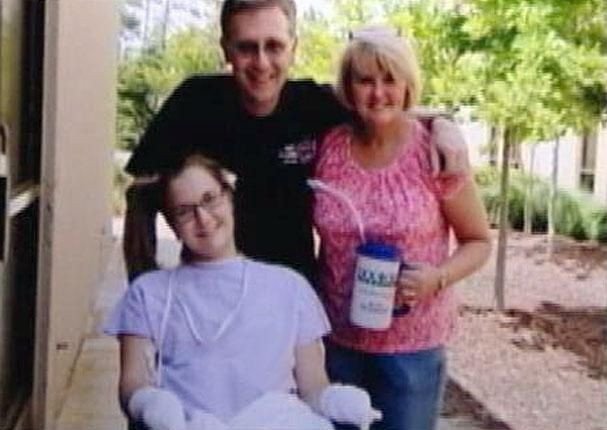Young Victim of Flesh-Eating Disease Who Lost Four Limbs Pictured for the First Time Since Amputations

Aimee Copeland, the 24-year-old graduate student from Georgia who fought for her life battling aggressive flesh-eating bacterial infection has been pictured for the first time since the disease claimed her four limbs.
The picture shows Amy outside for the first time in 49 days on Sunday smiling with her parents by her side and bandages covering the ends of her arms.
"Aimee has a beauty in this photograph that I think goes beyond words," Aimee's father, Andy Copeland, told Good Morning America on Tuesday. "It's a beauty of survival, of resilience."
Amiee condition had been upgraded from "serious" to good" by doctors on Monday, and her vital signs are stable and within normal limits, meaning that she is comfortable and her indicators are great.
Her father, Andy Copeland , told Good Morning America Tuesday morning that Aimee might be able to leave the hospital in a week.
Last weekend, Aimee had went outside for the first time since she was infected by with necrotizing fasciitis or the "flesh-eating disease" in early May after she cut her leg in a fall from a homemade zip line over a west Georgia river.
Her parents pushed her on a wheelchair as they all walked around the outside of the hospital.
"The look on Aimee's face was just incredible," Andy told Good Morning America. "She could smell the pine trees and feel the breeze through her hair and just the sun on her skin. That was a remarkable change for her just to see how she glowed when we took her outside."
Andy, who has been updating his blog about Aimee's status, wrote that Aimee told him during their time together that she felt lucky to have gone through such a transformative experience.
"I don’t have any regrets about what has happened," Andy wrote, quoting his daughter. "I don’t focus on what I’ve lost, I would rather focus on what I’ve gained. I feel like I’ve been blessed."
“I am blessed to be able to have a challenge that not many others get to have,” she had added. “I am blessed to have the capacity to share my experience with others and have a chance to improve the quality of someone else’s life. I’m blessed to be different.”
The University of West Georgia psychology graduate student had to have her left leg amputated, her right foot and both hands in order to save her life after a cut to her leg became infected.
Aimee had been kayaking along the Little Tallapoosa River in Carrollton, Georgia, last Tuesday when she stopped to take a ride on a home-made zip line. The line had snapped and she suffered a large cut on her left calf, which took 22 staples to close.
Doctors had initially told her to take Motrin and Tylenol for the pain, believing nothing to be wrong. After being released from doctor's care with nothing more than some antibiotics and pain killers, Aimee and her family were horrified to discover that aggressive flesh-eating bacteria had invaded her leg injury and was quickly invading the rest of her body.
Necrotizing fasciitis, commonly referred to as 'flesh-eating disease,' is a rare but extremely aggressive bacterial infection that develops when the aeromonas hydrophila bacteria enters the body, usually through a small cut or scrape. The bacteria quickly multiply and release toxins that destroy tissue and block blood flow to the area it infects.
Symptoms of the infections include small, red lumps or bumps on the skin, rapidly-spreading bruising, sweating, chills, fever and nausea, organ failure and shock. Infected patients need to be treated immediately to prevent death because infection spread quickly throughout the body causing sepsis.
Patients are treated with powerful antibiotics and surgery or even amputation to remove the dead or infested tissue.



























